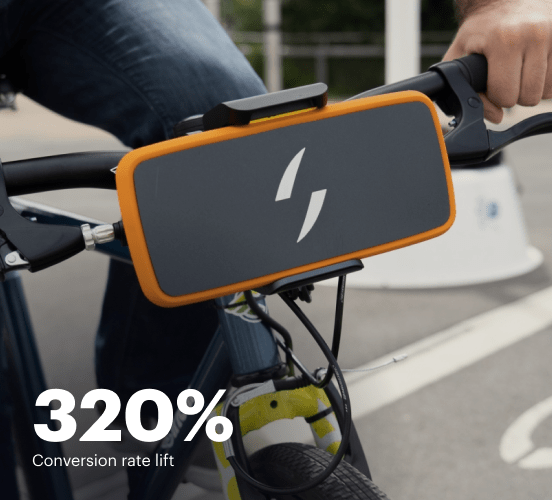How Paperform vs. Constant Contact vs. Instapage stack up against each other
Compare Instapage with Paperform and Constant Contact to create high-converting landing pages. With personalization, optimization, and collaboration tools, Instapage helps you deliver experiences that drive results.
Get startedSee how Instapage stacks up against the competition
| Feature | Instapage | Other builders |
| Drag-and-Drop Tools | ||
| Conversion-optimized templates | ||
| Manual and AI-powered A/B Tests | ||
| AI content suggestions | ||
| Popups and sticky bars | ||
| Canvas and grid blocks | ||
| Reusable and global elements | ||
| Form and popup builders | ||
| Built-in Heatmaps | ||
| Central analytics dashboard | ||
| Ad-to-page personalization and collections | ||
| Contacts, lists, and email | ||
| Dedicated, full-service CRO experts | ||
| Enterprise-ready platform |
Leading the way in building high-performing landing pages





Why Instapage is the smarter choice for your campaigns
Get everything you need to build, scale, and optimize high-converting landing pages—without coding.

Easier page building without coding
Instapage offers a flexible and seamless page creation experience with a library of 500+ conversion-focused layouts, Instablocks®, a drag-and-drop builder, and AI content generation. With technologies like Thor Render Engine®, you can create on-brand, mobile-responsive landing pages that load quickly and start converting during initial visitor clicks.

More insights — better results
Instapage lets you see in detail how each landing page experience and variation is performing so you can make targeted changes that boost page conversions. Use heatmaps for a better understanding of on-page activities, run A/B tests and AI-assisted experiments, and then track and evaluate results within robust analytics dashboards.

More personalized experiences
Instapage lets you quickly create high-performing landing pages tailored to each of your ad campaigns. Deliver personalized experiences for distinct audiences using dynamic text replacement. Effortlessly align specific advertisements to unique pages with AdMaps. Monitor audience-level metrics using our advanced data tools.

Built-in collaboration
Instapage collaboration capabilities bring your entire team together to speed up the process of landing page review, approval, and launch. No more frustrating and unnecessary revisions or edits scattered across emails. Provide instant feedback, conduct real-time page edits, and securely share your pages with outside stakeholders.

Free up time for your business
Invest time into business growth, not busy work. Launch landing pages faster with reusable forms and templates. Build once, reuse forever.
Explore all integrations






Easier page building without coding
Instapage offers a flexible and seamless page creation experience with a library of 500+ conversion-focused layouts, Instablocks®, a drag-and-drop builder, and AI content generation. With technologies like Thor Render Engine®, you can create on-brand, mobile-responsive landing pages that load quickly and start converting during initial visitor clicks.
More insights — better results
Instapage lets you see in detail how each landing page experience and variation is performing so you can make targeted changes that boost page conversions. Use heatmaps for a better understanding of on-page activities, run A/B tests and AI-assisted experiments, and then track and evaluate results within robust analytics dashboards.
More personalized experiences
Instapage lets you quickly create high-performing landing pages tailored to each of your ad campaigns. Deliver personalized experiences for distinct audiences using dynamic text replacement. Effortlessly align specific advertisements to unique pages with AdMaps. Monitor audience-level metrics using our advanced data tools.
Built-in collaboration
Instapage collaboration capabilities bring your entire team together to speed up the process of landing page review, approval, and launch. No more frustrating and unnecessary revisions or edits scattered across emails. Provide instant feedback, conduct real-time page edits, and securely share your pages with outside stakeholders.
Free up time for your business
Invest time into business growth, not busy work. Launch landing pages faster with reusable forms and templates. Build once, reuse forever.
Explore all integrationsGet started with Instapage in a few steps
-
Create your Instapage account
Start with Instapage by signing up via Google or your email. You'll get access to a free 14-day trial to discover Instapage capabilities. Feel free to cancel anytime during the 14-day trial if you decide that our product is not suitable for your business. -
Build and personalize your page
Create your first landing page from scratch or choose a template from 500+ customizable layouts. Use the drag-and-drop builder to add page elements, fonts, and backgrounds, refine content with AI, or add custom HTML, Javascript, and CSS. -
Review and make edits
Collaborate on page designs and streamline review processes. Invite your team members and stakeholders to review, edit, and provide feedback on your landing page. Collaborate knowing your page is confidential and only accessible to authorized users. -
Publish and track page performance
Publish your page to a domain or custom URL. Connect your pages to the ads you've created and track page performance within the analytics dashboard, run A/B tests and AI experiments, analyze results, and continuously optimize your landing page to maintain high conversions.
Instapage vs. Paperform vs. Constant Contact – The Ultimate Landing Page Showdown
Imagine you're picking the ultimate marketing team, where each member brings unique skills to the table. Just as superheroes team up to combat challenges, marketers also need the best tools to boost their campaigns. Today, we’re diving into a head-to-head comparison of three powerful contenders in the landing page arena: Instapage, Paperform, and Constant Contact. Each of these platforms boasts its own superpowers, but which one will ultimately lead your landing page strategies to victory? Let’s break down their strengths, weaknesses, and see how they stack up against each other in the quest for landing page perfection. It's not just about building pages; it's about reducing costs, growing conversions, and ensuring that each user has a landing experience that fosters brand trust and customer loyalty. (min:200 words)
Meet the Competitors – Our Star Line-Up
In the left corner, we have Instapage, a platform revered for its deep commitment to customization and conversion optimization. It empowers marketers to create tailored landing pages that resonate with their audience, ultimately driving higher conversion rates. In the right corner, we have Paperform, known for its user-friendly interface that allows for quick form building, making it a favorite for creators looking to launch landing pages rapidly. Finally, in the stable of champions, we introduce Constant Contact, a long-standing player in email marketing that has expanded its reach with impactful landing page features. Each of these platforms comes with its unique set of tools and capabilities aimed at attracting and engaging visitors, but which one will reign supreme in your marketing strategy? (min:200 words)
First Round – Features and Functionality Face-Off
Template Variety and User Experience: A Quick Comparison
When it comes to landing pages, having a diverse selection of templates is crucial. Instapage takes the lead here with a vast library of highly customizable templates that cater to various industries and needs. Users can easily modify designs to reflect their branding, ensuring a seamless transition for visitors. In contrast, Paperform also offers a commendable range of templates but focuses more on form-building capabilities than website landing pages explicitly. This offers users a quick solution for collecting leads, although it may not feature the depth of customization seen in Instapage. Lastly, Constant Contact, while having an adequate selection of templates, slightly lags in terms of customization options. Many users find that while they can develop functional landing pages, the creative freedom isn’t as extensive as with Instapage and Paperform. In short, if variety and ease of use are paramount, Instapage takes the cake. (min:200 words)
Instapage: The Powerhouse of Customization and Conversion Tools
Instapage stands out with its unmatched customization features that practically invite users to create landing pages that not only look great but are optimized for conversions. Its user-friendly drag-and-drop editor makes it easy for marketers of all skills to click their way to a stunning landing page. It also includes real-time collaboration tools, allowing teams to work together seamlessly. Additionally, Instapage integrates A/B testing directly within its platform, enabling users to refine landing page elements like headlines, images, and calls to action for peak performance. With features like heatmaps and analytics, Instapage provides marketers with valuable insights into user behavior, empowering them to reduce costs and grow conversions effectively. Overall, Instapage transcends being just a tool; it establishes itself as a true partner in the success of digital marketing efforts. (min:200 words)
Second Round – Speed and Performance Showdown
Let's shift our focus to the crucial aspect of speed and performance in the world of landing pages. Think of website speed as that extra shot of espresso you need to energize your day; a delay can lead to frustration and lost opportunities. A fast-loading landing page is vital for keeping potential customers engaged, and each contender takes a different approach to this essential aspect.
Instapage Speed Advantages:
- Instapage offers optimized templates designed for rapid loading.
- Built-in CDN ensures quick delivery of content worldwide.
- Automatic image compression features enhance load times.
- Advanced technical settings allow for further custom speed optimizations.
Paperform Speed Advantages:
- Simple to use interface allows for quick page creation.
- Forms load in the background, reducing visible wait time.
- Integrated analytics help monitor page performance efficiently.
Constant Contact Speed Advantages:
- Standardized templates that promote faster set-up times.
- Responsive designs are optimized for mobile speed.
- Regular updates ensure that platform performance remains competitive.
In conclusion, while all three platforms boast admirable speed and performance features, Instapage emerges as the leader in this round with its comprehensive optimizations aimed at delivering the best possible user experience. Speed is key, and Instapage consistently delivers. (min:200 words)
Third Round – Welcoming Usability and Learning Curve
A friendly tool can make all the difference in a marketer's journey. In this round, we explore how each platform caters to newcomers and seasoned veterans alike. Instapage emphasizes simplicity without compromising on depth, giving new users intuitive guidance alongside advanced features for expert users. The plethora of resources and tutorials further eases the learning curve, allowing users to channel their inner marketer with confidence. On the flip side, Paperform offers a highly visual interface, empowering users to build forms and landing pages with minimal technical skills. It is particularly alluring to creatives who want rapid results without getting bogged down in complex features. Constant Contact, while known for its robust email marketing tools, also provides a straightforward approach to landing page creation, albeit with a slightly steeper learning curve as users navigate its more diverse range of offerings. Overall, all platforms strive to make the onboarding process as friendly as possible, but Instapage’s balance of support and features is commendable. (min:200 words)
Fourth Round – Customer Support: Your Loyal Sidekick
Every great tool should have a reliable support system. Think of customer support as your trustworthy sidekick, ready and waiting to help when challenges arise. Instapage shines with its responsive customer service team, offering support via live chat, email, and an extensive knowledge base packed with articles and tutorials. Users can readily find solutions to common questions, ensuring that help is just a click away. Turning to Paperform, its customer service is also commendable, providing chat support and a rich library of resources. Still, some users report longer response times compared to Instapage. Constant Contact rounds out the picture with strong community engagement and numerous support options, including phone support, which is advantageous for those needing immediate assistance. While every platform offers satisfactory support, Instapage's quick responses and range of help resources solidify its position as a top-tier option. (min:200 words)
Fifth Round – Analyzing Pricing Structures and Plans
When it comes to pricing, each platform has its unique offerings tailored to different business needs. Instapage features a tiered pricing plan, which some may find a bit premium compared to its competitors; however, the power of its features often justifies the investment for businesses focused on conversions. Paperform adopts a flexible pricing model, allowing users to pay only for the features they need, making it a great fit for startups and smaller companies. Constant Contact's plans are diverse, integrating email marketing and landing page services, potentially presenting great value for businesses looking for an all-in-one tool. In concluding this round, the final choice often boils down to the specific needs of every marketer—particularly as it relates to expected features and budget flexibility. (min:200 words)
To sum it up, while each platform has its strengths and weaknesses, the right choice heavily relies on individual requirements. Understand what resonates most with your goals, whether it's features, support, or pricing flexibility. Regardless of your choice, each contender has the potential to elevate your marketing game. So why not kick the tires on Instapage with a free trial? It may just lead to higher conversions and user satisfaction. (min:200 words)










